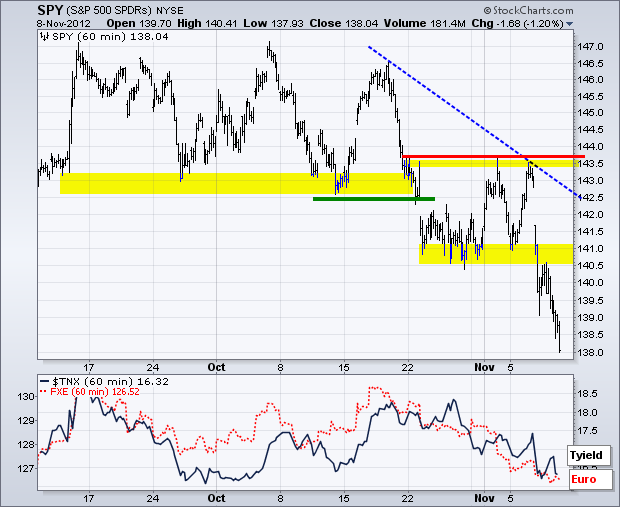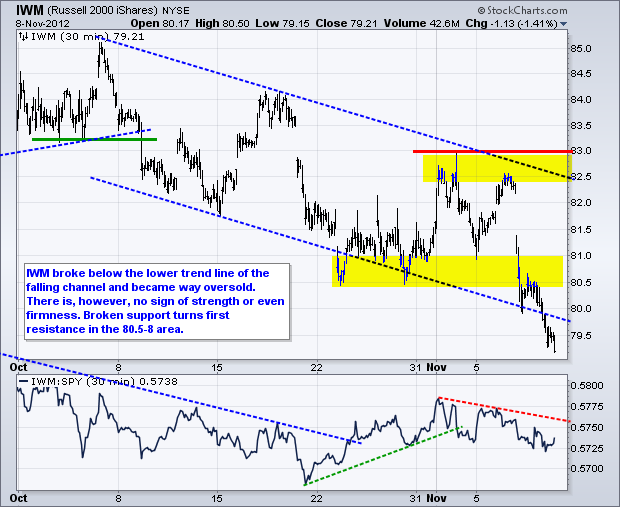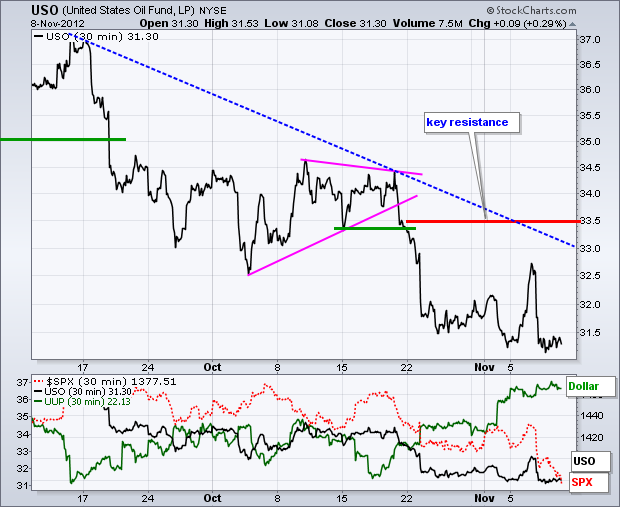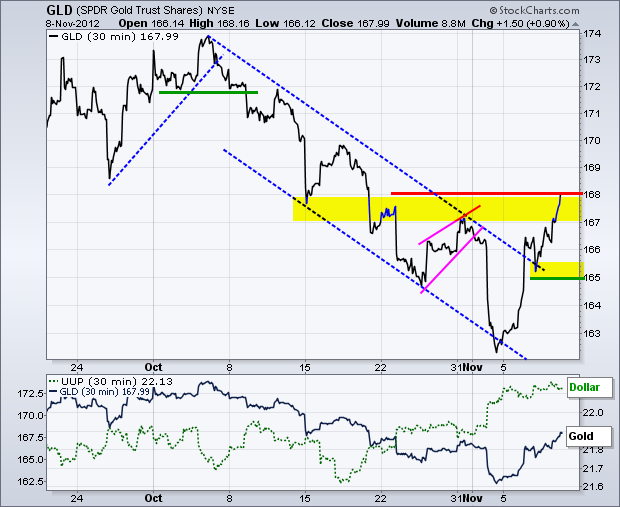Stocks remained under pressure on Thursday with the major index ETFs falling 1% or more. As has been the case for some time, the Russell 2000 ETF (IWM) and the Nasdaq 100 ETF (QQQ) led the way lower. All nine sectors were down with the Consumer Discretionary SPDR (XLY) and Energy SPDR (XLE) leading the way. Relative weakness in the consumer discretionary sector is not a good sign for the broader market. Also note that the Retail SPDR (XRT) fell over 2% and this is not a good sign as we head into the holiday season. XRT broke above the flag/channel trend line on Tuesday, but gave it all back on Wednesday-Thursday with a 4% plunge.



There is not much change as the downtrend extends. SPY failed at broken support and the early November high in the 143-143.50 area. These two peaks now mark key resistance. After hitting resistance, SPY plunged through the late October lows with a sharp decline on Wednesday-Thursday. Broken support here turns into the first resistance level in the 141 area. SPY is now short-term oversold and we could see a short consolidation or bounce. The indicator window shows the 10-year Treasury Yield ($TNX) and the Euro Currency Trust (FXE) falling along with the stock market.


**************************************************************************
The 20+ Year T-Bond ETF (TLT) broke resistance with a surge above 123.50 and continued higher on Thursday. The swing has been up since late October and this week's breakout reverses the medium-term downtrend. Broken resistance turns into first support in the 123-123.5 area and this week's low marks key support. Such strength in TLT favors the risk-off trade and this is bearish for stocks.

**************************************************************************
No change. The US Dollar Fund (UUP) surged to resistance in late October, consolidated and broke out with a surge on Friday. Perhaps the prospects of less quantitative easing triggered this buying binge. An improving economy and labor market put less pressure on the Fed for quantitative easing, which means less Dollar dilution. I am showing a longer 60-minute chart to highlight the magnitude of this breakout, which is medium-term bullish. Broken resistance turns first support in the 21.95 area. Key support is set at 21.85 for now.

**************************************************************************
No change. The US Oil Fund (USO) plunged along with the stock market and gave back all of its gains from Tuesday. This simply affirms the downtrend that has been in place since mid September. I am leaving key resistance at 33.50 to account for the mid September trend line. Dollar strength and stock market weakness are bearish for oil.

**************************************************************************
Something is up with gold. Treasuries are soaring in a flight to safety. Stocks are plunging as the eight-week downtrends extend. Oil is also plunging and the Dollar is in an uptrend. This recipe is normally bearish for gold, but the Gold SPDR (GLD) surged the last two days and is on the verge of a breakout at 168. Wednesday's low marks first support in the 165-165.5 area. As noted before, strength in the Dollar and gold is very bearish for stocks.

**************************************************************************
Key Reports and Events:
Fri - Nov 09 - 09:55 - Michigan Sentiment
Charts of Interest: Tuesday and Thursday
This commentary and charts-of-interest are designed to stimulate thinking. This analysis is not a recommendation to buy, sell, hold or sell short any security (stock ETF or otherwise). We all need to think for ourselves when it comes to trading our own accounts. First, it is the only way to really learn. Second, we are the only ones responsible for our decisions. Think of these charts as food for further analysis. Before making a trade, it is important to have a plan. Plan the trade and trade the plan. Among other things, this includes setting a trigger level, a target area and a stop-loss level. It is also important to plan for three possible price movements: advance, decline or sideways. Have a plan for all three scenarios BEFORE making the trade. Consider possible holding times. And finally, look at overall market conditions and sector/industry performance.


**************************************************************************
The 20+ Year T-Bond ETF (TLT) broke resistance with a surge above 123.50 and continued higher on Thursday. The swing has been up since late October and this week's breakout reverses the medium-term downtrend. Broken resistance turns into first support in the 123-123.5 area and this week's low marks key support. Such strength in TLT favors the risk-off trade and this is bearish for stocks.

**************************************************************************
No change. The US Dollar Fund (UUP) surged to resistance in late October, consolidated and broke out with a surge on Friday. Perhaps the prospects of less quantitative easing triggered this buying binge. An improving economy and labor market put less pressure on the Fed for quantitative easing, which means less Dollar dilution. I am showing a longer 60-minute chart to highlight the magnitude of this breakout, which is medium-term bullish. Broken resistance turns first support in the 21.95 area. Key support is set at 21.85 for now.

**************************************************************************
No change. The US Oil Fund (USO) plunged along with the stock market and gave back all of its gains from Tuesday. This simply affirms the downtrend that has been in place since mid September. I am leaving key resistance at 33.50 to account for the mid September trend line. Dollar strength and stock market weakness are bearish for oil.

**************************************************************************
Something is up with gold. Treasuries are soaring in a flight to safety. Stocks are plunging as the eight-week downtrends extend. Oil is also plunging and the Dollar is in an uptrend. This recipe is normally bearish for gold, but the Gold SPDR (GLD) surged the last two days and is on the verge of a breakout at 168. Wednesday's low marks first support in the 165-165.5 area. As noted before, strength in the Dollar and gold is very bearish for stocks.

**************************************************************************
Key Reports and Events:
Fri - Nov 09 - 09:55 - Michigan Sentiment
Charts of Interest: Tuesday and Thursday
This commentary and charts-of-interest are designed to stimulate thinking. This analysis is not a recommendation to buy, sell, hold or sell short any security (stock ETF or otherwise). We all need to think for ourselves when it comes to trading our own accounts. First, it is the only way to really learn. Second, we are the only ones responsible for our decisions. Think of these charts as food for further analysis. Before making a trade, it is important to have a plan. Plan the trade and trade the plan. Among other things, this includes setting a trigger level, a target area and a stop-loss level. It is also important to plan for three possible price movements: advance, decline or sideways. Have a plan for all three scenarios BEFORE making the trade. Consider possible holding times. And finally, look at overall market conditions and sector/industry performance.

About the author:
Arthur Hill, CMT, is the Chief Technical Strategist at TrendInvestorPro.com. Focusing predominantly on US equities and ETFs, his systematic approach of identifying trend, finding signals within the trend, and setting key price levels has made him an esteemed market technician. Arthur has written articles for numerous financial publications including Barrons and Stocks & Commodities Magazine. In addition to his Chartered Market Technician (CMT) designation, he holds an MBA from the Cass Business School at City University in London.
Learn More





